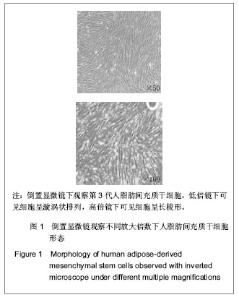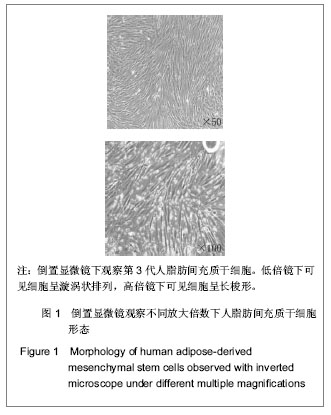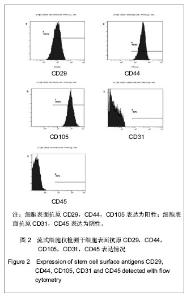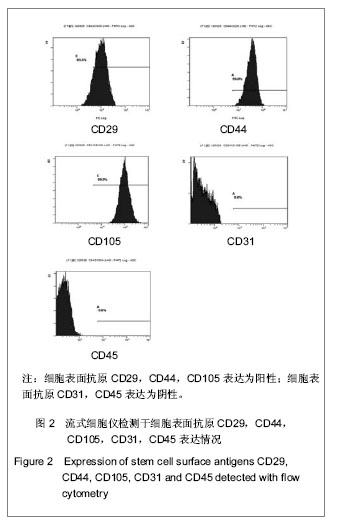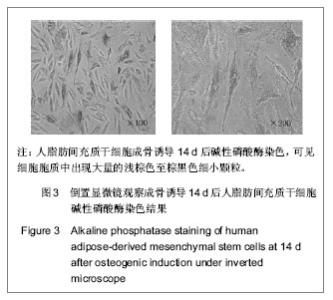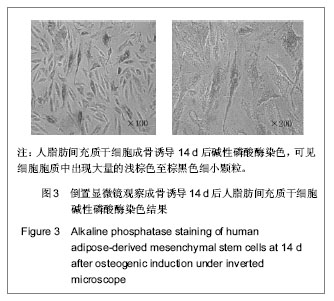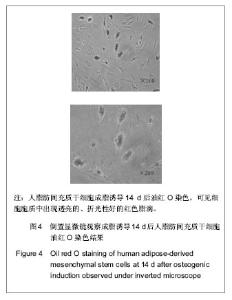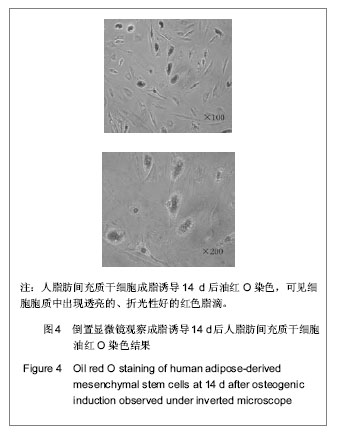Chinese Journal of Tissue Engineering Research ›› 2013, Vol. 17 ›› Issue (14): 2517-2524.doi: 10.3969/j.issn.2095-4344.2013.14.007
Previous Articles Next Articles
Recombinant human bone morphogenetic protein-2 adjusts expression of vascular endothelial growth factor in human adipose-derived mesenchymal stem cells
Cao Xin, Jin Ge-le, Yang Yi, Chen Hui-jin, Yin Jian
- VIP Ward, Second Department of General Surgery, the First Affiliated Hospital of Xinjiang Medical University, Urumqi 830000, Xinjiang Uygur Autonomous Region, China
-
Received:2012-11-02Revised:2012-11-20Online:2013-04-02Published:2013-04-02 -
Contact:Jin Ge-le, Doctor, Professor, Chief physician, VIP Ward, Second Department of General Surgery, the First Affiliated Hospital of Xinjiang Medical University, Urumqi 830000, Xinjiang Uygur Autonomous Region, China jingl81@yahoo.com.cn -
About author:Cao Xin★, Studying for master’s degree, VIP Ward, Second Department of General Surgery, the First Affiliated Hospital of Xinjiang Medical University, Urumqi 830000, Xinjiang Uygur Autonomous Region, China demonleaf@163.com -
Supported by:Natural Science Foundation-Funded Youth Project in Xinjiang Autonomous Region, No. 2012211B32; Doctoral Fund of Universities, No. 20116517120001; Project of Supporting Xinxiang with Science and Technology, No. 201191262
CLC Number:
Cite this article
Cao Xin, Jin Ge-le, Yang Yi, Chen Hui-jin, Yin Jian. Recombinant human bone morphogenetic protein-2 adjusts expression of vascular endothelial growth factor in human adipose-derived mesenchymal stem cells[J]. Chinese Journal of Tissue Engineering Research, 2013, 17(14): 2517-2524.
share this article
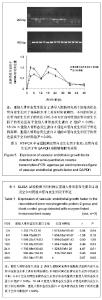
2.5 RT-PCR以及ELISA检测不同时间重组人骨形态发生蛋白2诱导下血管内皮生长因子表达 在基因水平和蛋白水平均证实重组人骨形态发生蛋白2调节脂肪间充质干细胞表达血管内皮生长因子具有时间依赖性。RT-PCR结果显示,重组人骨形态发生蛋白2诱导组在3,6 h血管内皮生长因子的表达量低于对照组(P < 0.05),12 h的血管内皮生长因子表达出现下降,18- 24 h表达重新上升并达到高峰,36,48 h血管内皮生长因子表达明显减少。对照组3,6 h血管内皮生长因子处于较高水平,12 h表达下降,18-24 h表达上升但是低于重组人骨形态发生蛋白2诱导组(P < 0.05),36,48 h表达明显减少。 ELISA 结果证实血管内皮生长因子在蛋白水平上表达的时间依赖性与RT-PCR所检测的血管内皮生长因子在基因水平上的时间依赖性相一致,见图5及表1。"
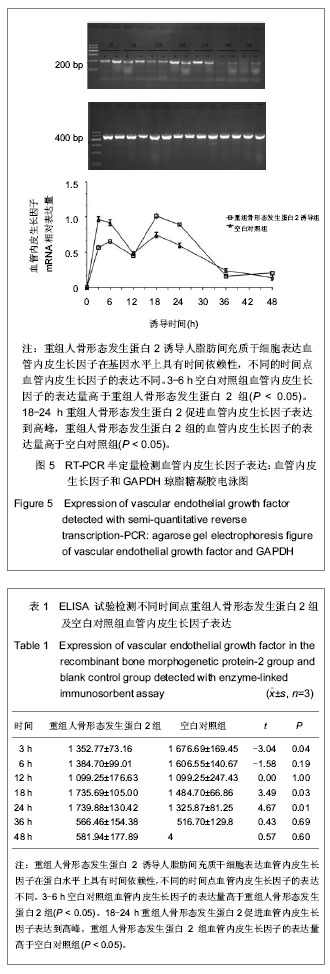
| [1] Novosel EC, Kleinhans C, Kluger PJ. Vascularization is the key challenge in tissue engineering. Adv Drug Deliv Rev. 2011;6(3):300-311. [2] Xu HZ,Su JS.Zhonghua Linchuang Yishi Zazhi.2010;4(4): 456-458.徐红珍,苏俭生.组织工程骨血管化研究进展[J].中华临床医师杂志:电子版,2010,4(4):456-458[3] Schubert T, Xhema D, Vériter S, et al.The enhanced performance of bone allografts using osteogenic-differentiated adipose-derived mesenchymal stem cells. Biomaterials. 2011;32:8880-8891. [4] Park DK, Ji YH, Dhong ES, et al. Transplantation of Rat Adipose- Derived Stem Cells (ASCs) to Improve the Survival of Autologous Aspirated Fat Grafts. Tissue Engineer Regenerat Med. 2012;9(2):69-74.[5] Yang Y, Jin GL, Tang ZZ, et al. Zhonghua Shiyan Waike Zazhi. 2010;27(2): 245-247.杨毅,金格勒,唐周舟,等.复合骨在兔腰椎融合过程中相关基因表达调控的影响[J].中华实验外科杂志, 2010, 27(2):245-247.[6] Trubiani O,Fulle S,Traini T,et al.Functional assay, expression of growth factors and proteins modulating bone-arrangement in human osteoblasts seeded on an anorganic bovine bone biomaterial. Eur Cell Mater. 2010;20:72-83. [7] Kim SE, Song SH, Yun YP, et al. The effect of immobilization of heparin and bone morphogenic protein-2(BMP-2)to titanium surfaces on inflammation and osteoblast function. Biomaterials. 2011;32(2):366-378.[8] Hwang CJ,Vaccaro AR,Lawrence JP, et al. Immunogenicity of bone mor- phogenetic proteins. J Neurosurg Spine. 2009; 10(5):443-451.[9] Tumialán LM,Rodts GE. Adverse swelling associated with use of rh-BMP-2 in anterior cervical discectomy and fusion. Spine J. 2007;7(4):509-510.[10] Cui L,Yin S,Liu W,et al. Expanded adipose-derived stem cells suppress mixed Lymphocyte reaction by secretion of prostaglandinE2. Tissue Eng. 2007;13(6):1185-1195.[11] Zuk PA, Zhu M, Ashjian P, et al. Human adipose tissue is a source of multipotent stem cells. Mol Biol Cell. 2002;13(12): 4279-4295.[12] Liu Q, Cen L, Zhou H, et al. The role of the extracellular signal-related kinase signaling pathway in osteogenic differentiation of human adipose-derived stem cells and in adipogenic transition initiated by dexamethasone. Tissue Eng Part A. 2009;15(11):3487-3497.[13] Bi XJ, Ma Y, Jiang M.Zhongguo Zuzhi Gongcheng Yanjiu yu Linchuang Kangfu. 2011;15(14):2512-2516.毕晓娟,马艳,江明.大鼠腹股沟脂肪间充质干细胞的分离、培养、鉴定及活体标记[J].中国组织工程研究与临床康复,2011,15(14): 2512-2516.[14] Tang CL,Mahoney JL. Donor site morbidity following vascularized fibular grafting.Microsurgery. 1998;18(6): 383-386.[15] Nkenke E,Weisbach V,Winckler E,et al. Morbidity of harvesting of bone grafts from the iliac crest for preprosthetic augmentation procedures: a prospective study. Int J Oral Maxillofac Surg. 2004;33(2): 157-163. [16] Gazdag AR, Lane JM, Glaser D, et al. Alternatives to autogenous bone graft: efficacy and indications. J Am Acad Orthop Surg. 1995;3(1):1-8.[17] Bohner M, Galea L, Doebelin N. Calcium phosphate bone graft substitutes: Failures and hopes. J Europ Ceram Society. 2012;32(11):2263-2271.[18] Logeart-Avramoglou D,Anagnostou F,Bizios R,et al.Engineering bone: challenges and obstacles. J Cell Mol Med. 2005;9(1):72–84.[19] Nguyen LH, Annabi N, Nikkhah M, et al. Vascularized bone tissue engineering: approaches for potential improvement. Tissue Eng Part B Rev. 2012;18(5):363-382. [20] Woodruff MA, Lange C, Reichert J, et al. Bone tissue engineering: from bench to bedside. Mat Today. 2012; 15(10):430-435.[21] Park CH, Rios HF, Jin Q, et al. Tissue engineering bone-ligament complexes using fiber-guiding scaffolds. Biomaterials. 2012;33(1):137-145.[22] Cao H, Kuboyama N. A biodegradable porous composite scaffold of PGA/β-TCP for bone tissue engineering. Bone. 2010;46(2):386-395. [23] Jakob M, Saxer F, Scotti C,et al.Perspective on the Evolution of Cell-Based Bone Tissue Engineering Strategies. Eur Surg Res. 2012;49(1):1-7. [24] Seebach C, Henrich D, Kähling C, et al. Endothelial Progenitor Cells and Mesenchymal Stem Cells Seeded onto β-TCP Granules Enhance Early Vascularization and Bone Healing in a Critical-Sized Bone Defect in Rats. Tissue Eng Part A. 2010;16(6):1961-1970. [25] Zou D, Zhang Z, He J, et al.Blood vessel formation in the tissue-engineered bone with the constitutively active form of HIF-1a mediated BMSCs. Biomaterials. 2012;33(7):2097- 2018. [26] Song I, Kim BS, Kim CS, et al.Effects of BMP-2 and vitamin D3 on the osteogenic differentiation of adipose stem cells. Biochem Biophys Res Commun. 2011;408(10):126-131. [27] Yan MN, Dai KR, Tang TT,et al. Reconstruction of peri-implant bone defects using impacted bone allograft and BMP-2 gene-modified bone marrow stromal cells. J Biom Mater Res Part A. 2010;93(1):304-313. [28] Fu DH,Yang JH,Liu GH,et al.Zhonghua Chuangshang Guke Zazhi.2007;9(10): 946-966. 傅德皓,杨进华,刘国辉,等.骨形态发生蛋白2促进鼠胚成骨细胞血管内皮生长因子表达的机制研究[J].中华创伤骨科杂志,2007, 9(10):964-966.[29] Jin GL,Ren LL. Zhonghua Chuangshang Guke Zazhi. 2010; 11(12):1065-1068.金格勒,任龙龙.重组人骨形态发生蛋白一2/异体骨复合骨用于兔腰椎融合的正电子发射计算机体层摄影一CT研究[J].中华创伤骨科杂志, 2010, 11(12):1065-1068.[30] Mladenov KV, Kunkel P, Stuecker R. The use of recombinant human BMP-2 as a salvage procedure in the pediatric spine: a report on 3 cases. Eur Spine J. 2010;1(9):135-139. [31] Brower RS,Vickroy NM. A case of psoas ossification from the use of BMP-2 for posterolateral fusion at L4-L5. Spine. 2008; 3(18):653-655.[32] Perri B, Cooper M, Lauryssen C, et al. Adverse swelling associated with use of rh-BMP-2 in anterior cervical discectomy and fusion: a case study. Spine J. 2007;7(2): 235-239. [33] Levi B, Nelson ER, Hyun JS, et al. Enhancement of Human Adipose-Derived Stromal Cell Angiogenesis through Knockdown of a BMP-2 Inhibitor. Plast Reconstr Surg. 2012; 129(1):53-66. [34] Wildemann B, Lang K, Strobe C,et al.Local BMP-2 application can rescue the delayed osteotomy healing in a rat model. Injury. 2011;42(8):746-752. |
| [1] | Pu Rui, Chen Ziyang, Yuan Lingyan. Characteristics and effects of exosomes from different cell sources in cardioprotection [J]. Chinese Journal of Tissue Engineering Research, 2021, 25(在线): 1-. |
| [2] | Zhang Xiumei, Zhai Yunkai, Zhao Jie, Zhao Meng. Research hotspots of organoid models in recent 10 years: a search in domestic and foreign databases [J]. Chinese Journal of Tissue Engineering Research, 2021, 25(8): 1249-1255. |
| [3] | Wang Zhengdong, Huang Na, Chen Jingxian, Zheng Zuobing, Hu Xinyu, Li Mei, Su Xiao, Su Xuesen, Yan Nan. Inhibitory effects of sodium butyrate on microglial activation and expression of inflammatory factors induced by fluorosis [J]. Chinese Journal of Tissue Engineering Research, 2021, 25(7): 1075-1080. |
| [4] | Wang Xianyao, Guan Yalin, Liu Zhongshan. Strategies for improving the therapeutic efficacy of mesenchymal stem cells in the treatment of nonhealing wounds [J]. Chinese Journal of Tissue Engineering Research, 2021, 25(7): 1081-1087. |
| [5] | Liao Chengcheng, An Jiaxing, Tan Zhangxue, Wang Qian, Liu Jianguo. Therapeutic target and application prospects of oral squamous cell carcinoma stem cells [J]. Chinese Journal of Tissue Engineering Research, 2021, 25(7): 1096-1103. |
| [6] | Xie Wenjia, Xia Tianjiao, Zhou Qingyun, Liu Yujia, Gu Xiaoping. Role of microglia-mediated neuronal injury in neurodegenerative diseases [J]. Chinese Journal of Tissue Engineering Research, 2021, 25(7): 1109-1115. |
| [7] | Li Shanshan, Guo Xiaoxiao, You Ran, Yang Xiufen, Zhao Lu, Chen Xi, Wang Yanling. Photoreceptor cell replacement therapy for retinal degeneration diseases [J]. Chinese Journal of Tissue Engineering Research, 2021, 25(7): 1116-1121. |
| [8] | Jiao Hui, Zhang Yining, Song Yuqing, Lin Yu, Wang Xiuli. Advances in research and application of breast cancer organoids [J]. Chinese Journal of Tissue Engineering Research, 2021, 25(7): 1122-1128. |
| [9] | Wang Shiqi, Zhang Jinsheng. Effects of Chinese medicine on proliferation, differentiation and aging of bone marrow mesenchymal stem cells regulating ischemia-hypoxia microenvironment [J]. Chinese Journal of Tissue Engineering Research, 2021, 25(7): 1129-1134. |
| [10] | Zeng Yanhua, Hao Yanlei. In vitro culture and purification of Schwann cells: a systematic review [J]. Chinese Journal of Tissue Engineering Research, 2021, 25(7): 1135-1141. |
| [11] | Kong Desheng, He Jingjing, Feng Baofeng, Guo Ruiyun, Asiamah Ernest Amponsah, Lü Fei, Zhang Shuhan, Zhang Xiaolin, Ma Jun, Cui Huixian. Efficacy of mesenchymal stem cells in the spinal cord injury of large animal models: a meta-analysis [J]. Chinese Journal of Tissue Engineering Research, 2021, 25(7): 1142-1148. |
| [12] | Hou Jingying, Yu Menglei, Guo Tianzhu, Long Huibao, Wu Hao. Hypoxia preconditioning promotes bone marrow mesenchymal stem cells survival and vascularization through the activation of HIF-1α/MALAT1/VEGFA pathway [J]. Chinese Journal of Tissue Engineering Research, 2021, 25(7): 985-990. |
| [13] | Shi Yangyang, Qin Yingfei, Wu Fuling, He Xiao, Zhang Xuejing. Pretreatment of placental mesenchymal stem cells to prevent bronchiolitis in mice [J]. Chinese Journal of Tissue Engineering Research, 2021, 25(7): 991-995. |
| [14] | Liang Xueqi, Guo Lijiao, Chen Hejie, Wu Jie, Sun Yaqi, Xing Zhikun, Zou Hailiang, Chen Xueling, Wu Xiangwei. Alveolar echinococcosis protoscolices inhibits the differentiation of bone marrow mesenchymal stem cells into fibroblasts [J]. Chinese Journal of Tissue Engineering Research, 2021, 25(7): 996-1001. |
| [15] | Fan Quanbao, Luo Huina, Wang Bingyun, Chen Shengfeng, Cui Lianxu, Jiang Wenkang, Zhao Mingming, Wang Jingjing, Luo Dongzhang, Chen Zhisheng, Bai Yinshan, Liu Canying, Zhang Hui. Biological characteristics of canine adipose-derived mesenchymal stem cells cultured in hypoxia [J]. Chinese Journal of Tissue Engineering Research, 2021, 25(7): 1002-1007. |
| Viewed | ||||||
|
Full text |
|
|||||
|
Abstract |
|
|||||
